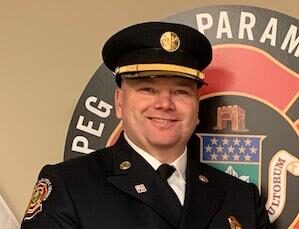
From fire to EM: Q&A with Winnipeg’s assistant chief of emergency management Jason Shaw
November 17, 2022
By
Haley Nagasaki

Raised in Winnipeg, Jason Shaw has spent the last 24 years serving as an emergency manager, a firefighter and firefighter paramedic. In 2017 he was promoted to assistant chief of emergency management and public information for the Winnipeg Fire Paramedic Service (WFPS).
Shaw leads the Office of Emergency Management (OEM) ensuring the city is operationally prepared for potential hazards and risks. His responsibilities are pillared by response, mitigation, preparedness, and recovery action, leading a team of emergency managers who hold a vast array of experience and expertise.
Bearing witness to the inception of Avert, Shaw sits on the editorial advisory board along with five other professionals nationwide who are lending their experience and networks to help steer editorial content for the new platform.
We recently connected with Shaw to get his take on the challenges and opportunities facing disaster management in Canada.
Avert: What are your current and past roles as they relate to the field of disaster and emergency management?
Shaw: I was a medic and firefighter paramedic from basically 1998 onward. I left the floor and took a desk job in 2015 and was fortunate enough to learn from senior leaders in our organization. In 2017, I was promoted to the rank of assistant chief, so my background is fire and EMS. Before that, I was teaching CPR and first-aid courses and working in hospital emergency rooms as a registered orthopedic technologist.
Avert: How long have you been involved in disasters or related fields and what are some highlights of your career thus far?
Shaw: I’ve been involved in disaster management, depending on how you look at it, since 2008 when I started taking courses at the Justice Institute of British Columbia (JIBC) and began my graduate studies at Royal Roads University in 2010.
In 2014, I was assisting the then-current emergency manager – learning the trade trough mentorship. When it came time for their retirement, the WFPS needed a new emergency manager. I was grateful to have been given the opportunity to step up and build the OEM, which has been one of the many highlights of my career thus far.
Our team has been charged with leading several major incidents, from fires to flood, major evacuations and, of course, we took the lead role in our city’s response to the COVID pandemic.
Avert: What do you see as the biggest challenge facing emergency managers and the disaster management system in Canada?
Shaw: I’ll answer it this way: for us, the main responsibility for our team is to be operationally ready through co-ordination and collaboration. Although this depends on the type of emergency manager because it’s segmented now; there are so many specialties of emergency management.
If we start on the macro big picture, the biggest challenge is the recognition that we need a united front because the complexity and frequency of incidents are increasing faster than the profession can keep up with. What we used to see as one in 100-year problems are now one in five-year problems.
One of the biggest challenges – though depending on how you look at it, is also a strong benefit – is that the profession is growing in many different risk areas with many subspecialties. Our job will be to continue to define and maintain strong communications between all these lanes of professionals to keep from creating silos across the field.
Avert: Similarly, what do you see as the biggest opportunity?
Shaw: Well, I think there’s opportunity for growth and education. Growth in the academic world in terms of educational programs for tacticians, policy folks and research. There is also an opportunity to better educate the public as evidently there is a ton of work to do to build resilient communities, and that starts with the individual.
Within each EM pillar there is potential for growth and the opportunity to do more; to specialize and to really support the overall goals of disaster mitigation. Recovery used to be an afterthought of emergency management and it has now taken its rightful place alongside response, mitigation, and preparedness, where in some areas there’s perhaps more focus on academic and tactical specialization.
EM professionals have cut out their niche, encouraging opportunities to really define roles and subsets of emergency management. What that looks like from the narrative of the big picture is truly exciting as we are going to continue seeing more complex disasters.
It’s great time to learn and to grow your career in EM!
Print this page